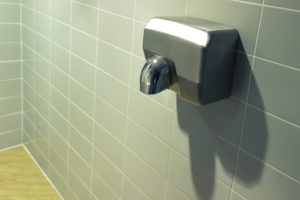To test this theory, scientists exposed petri dishes to bathroom air under different conditions and took them back to the microbiology laboratory to look for bacterial growth. Petri dishes exposed to bathroom air for two minutes with the hand dryers off only grew one colony of bacteria, or none at all. However, petri dishes exposed to hot air from a bathroom hand dryer for 30 seconds grew up to 254 colonies of bacteria (though most had from 18 to 60 colonies of bacteria).
Were the bacteria multiplying inside the hand dryers, or were they being pulled into the hand dryers from the air inside the bathroom? To answer this question, the researchers attached high-efficiency particulate air (HEPA) filters to the dryers, which would eliminate most of the bacteria from the air passing through the dryer. When they exposed petri dishes to air from the hand dryers again, the quantity of bacteria in the dishes had fallen by 75%. As well, the researchers found minimal amounts of bacteria on the nozzles of the hand dryers. They concluded that most of the bacterial splatter from the hand dryers had come from the washroom air.

How did the bacteria get into the air in the first place? Unfortunately, every time a lidless toilet is flushed, it aerosolizes a fine mist of microbes. This fecal cloud may disperse over an area as large as six square meters (65 square feet). Aerosols from flushed toilets may be especially harmful in the hospital setting as a means of spreading Clostridium difficile.
Is there any good news from this study? Well, the vast majority of the microbes that were detected do not cause disease in healthy people, with the exception of Staphylococcus aureus. Some of the bathroom bacteria, such as Acinetobacter, only cause infections in people in the hospital, or in those with weak immune systems. The others that were found are relatively harmless. In addition, air from real-world bathrooms may contain fewer bacteria than the bathrooms in the study. The sampled restrooms were located in a university health sciences building, and at least some of the bacteria came from experiments going on in laboratories within the building.
So what’s a person to do to avoid picking up bacteria in a bathroom? You should still dry your hands, as not drying them after washing them helps bacteria to survive on them. Paper towels are the most hygienic way to dry your hands. For this reason, use of paper towels is already routine in health care settings. You may also wish to avoid jet air dryers, which have also been associated with the spread of germs in bathrooms. And remember that your chances of picking up a serious pathogen in a restroom are small. Direct contact with other people is much more likely as a means of acquiring infection.
(Reprinted with permission from the Harvard Gazette.)














